March 1, 2013
Air Date: March 1, 2013
FULL SHOW
SEGMENTS
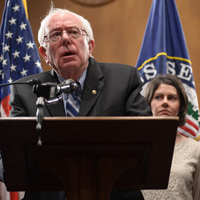
Senate Climate Bill
View the page for this story
President Obama promises executive action on global warming, if Congress fails to enact climate legislation. Now Senator Barbara Boxer of California and Senator Bernie Sanders of Vermont have introduced a climate bill that includes, among other measures, a tax on carbon emissions. Senator Bernie Sanders discusses the legislation with host Steve Curwood. (14:55)
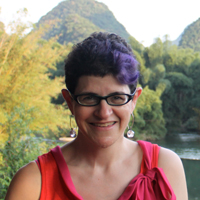
Chinese Carbon Tax
View the page for this story
Some US politicians argue that it's pointless for the United States to take action on climate change until the Chinese curb their emissions. But an official in China's Ministry of Finance recently wrote an article advocating a tax on carbon. Deborah Seligsohn, a researcher at University California at San Diego, tells host Steve Curwood that the Chinese are taking climate change more seriously than many people think. (05:45)
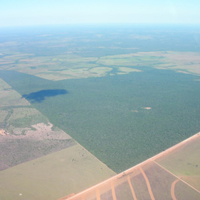
Amazon Deforestation on the Rise
/ Bobby BascombView the page for this story
After more than 6 years of steady declines the deforestation rate in the Brazilian Amazon has more than doubled in the last six months. Observers blame the deforestation in part on changes that weakened Brazil’s Forest Code. Living on Earth’s Bobby Bascomb reports on that, and new citizen initiatives to monitor what's happening in the Amazon region. (12:25)

Science Note: A Plant With Oily Leaves
/ Naomi ArenbergView the page for this story
In a bid to increase biofuel extraction from plants, researchers at Michigan State University engineered a plant with high levels of oil in its leaves. Naomi Arenberg reports. (01:55)
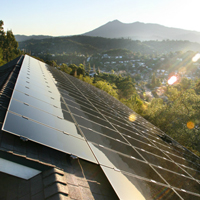
Honda and Solar Energy
View the page for this story
The car company Honda has announced a new incentive plan to offer customers solar panels on their homes. Ryan Harty, American Honda’s assistant manager for environmental business development, tells host Steve Curwood that building solar infrastructure can help Honda meet it CO2 reduction goals, and might perhaps sell more electric vehicles in the future. (06:30)

The Vital Role of Bacteria
/ Ari Daniel ShapiroView the page for this story
Bacteria exist by the billions everywhere on our planet, and they are vital for the creation of soil and every phase of life for all organisms. Ari Daniel Shapiro reports from the series, One Species at a Time, from the Encyclopedia of Life. (05:40)
Show Credits and Funders
Show Transcript
HOST: Steve Curwood
GUESTS: Bernie Sanders, Deborah Seligsohn, Ryan Harty
REPORTERS: Bobby Bascomb, Naomi Arenberg, Ari Daniel Shapiro
[THEME]
CURWOOD: From Public Radio International, this is Living on Earth. I'm Steve Curwood. A pair of leading Senators launches a bill to phase in a carbon tax - they say Congress must act to curb climate disruption before it's too late.
SANDERS: My fear is that if Congress does not get our act together, you're going to see more and more extreme weather disturbances, more and more problems, which will cost this country and this planet a hell of a lot more than the legislation that Barbara Boxer and I have introduced.
CURWOOD: How a carbon tax would work, and why it's so urgent. Also, in order to survive and thrive, plants depend on bacteria clinging to their roots.
KOLTER: They secrete some compounds that we know help in the growth of the plant. They also secrete compounds that are anti-fungal agents – actually, they go out and kill potentially dangerous fungi.
CURWOOD: The microbial circle of life and more this week, on Living on Earth. Stick around.
[THEME]
ANNOUNCER: Support for Living on Earth comes from Stonyfield Farm.
Senate Climate Bill
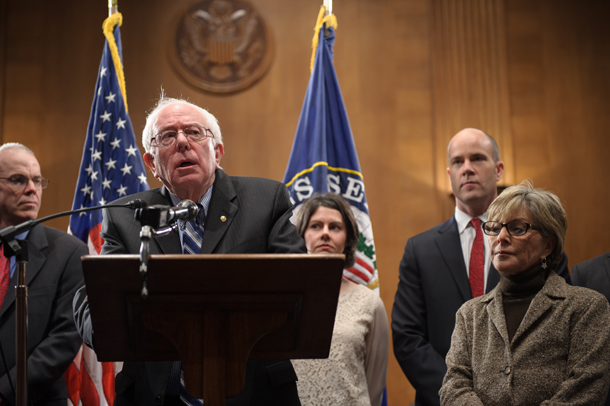
US Senator Sanders speaking at the press conference for his carbon tax bill, Senator Barbara Boxer on the right. (photo: Senator Bernie Sanders)
CURWOOD: From the Jennifer and Ted Stanley Studios in Boston, this is Living on Earth. I'm Steve Curwood.
With John Kerry now Secretary of State, leadership for the crusade to address climate change in the United States Senate has passed to Environment Committee Chair Barbara Boxer of California and Independent Bernie Sanders of Vermont. And the two have wasted little time in taking up the challenge of President Obama, who has vowed to take executive action on climate change if the Congress fails to act.
Senators Boxer and Sanders have introduced legislation that would, among other measures, impose a twenty dollar per ton fee on carbon emissions that would be mostly rebated to households. Senator Sanders joins us now from Washington, DC. Welcome to Living on Earth!
SANDERS: Thank you for having me.
CURWOOD: So the centerpiece of your bill is what you're calling a fee and dividend on carbon emissions. How would that work?
SANDERS: Well, the good news here is that what we are doing is focusing on the 3,000 largest emitters of greenhouse gas in the country, putting a fee of $20 per ton of carbon or methane equivalent.
CURWOOD: So this will be what, the oil refinery?
SANDERS: Coal mines, the oil refineries, the natural gas processing plants, or at the point of importation as well - which would deal with about 85 percent of the greenhouse gas emissions. So this is not going to be a fee, which impacts tens and tens and tens of thousands of entities. It's kind of what we call an "upstream”, where the emissions take place.
CURWOOD: So how exactly would it work? How would you impose this?
SANDERS: Look. Here’s the point. Here's the point before we get into all of the details. The important issue to understand right now is that according to the scientific community, we stand the danger of seeing the planet Earth temperature rise by 8°F by the end of this century. If that happens, and we’ve talked to many of the leading scientists who study this issue, what they are telling us is this will cause catastrophic - underline catastrophic - damage to the planet. What we already know is that 12 out of the last 15 years have been the warmest on record. We already know that we’re looking at unprecedented levels of drought, of floods, of extreme weather disturbances like Hurricane Irene or Hurricane Sandy. We’re looking at the continent of Australia burning up. We’re looking at heat waves in Europe the people have never seen before.
The most important issue before we worry about every line of any legislation is, is the Congress of the United States going to wake up and say we have a planetary crisis here and we have got to address it. And if you ask me, and I already deal with a lot of issues out there, my greatest embarrassment of being a member of the United States Congress right now, it is that you have a major political party, the Republican Party, who refuses to listen to what the scientists are saying. You have the ranking member, from a ranking member of the Environmental Committee telling us if you could believe it, that the climate change is a hoax perpetrated by Al Gore and the Hollywood elite and United Nations. I mean, that's where we are. And my fear is that if Congress does not get our act together, you're gonna see more and more extreme weather disturbances, more and more problems which will cost this country and this planet a hell of a lot more than the legislation that Barbara Boxer and I have introduced.
CURWOOD: This carbon fee, this effective carbon tax, where would the money raised from these fees go?
SANDERS: Good question. Among other things, a lot of the money - actually the majority of the money - would go back to the people of United States to help them with any increased energy costs they may incur as we begin to transform our energy system away from fossil fuels. Some people will be forced to pay more for fuel and they will. A lot of money we’re raising, we expect to raise about $1.2 trillion over a 10-year-period. The majority of that money goes right back to the American people to help them pay for increased fuel cost. Significantly we also put a whole lot of money in weatherization, we would rather weatherize a million homes a year.
We would put money into research and development for breakthroughs in energy...how can we move more aggressively to sustainable energy? A lot of research being done out there, and we want to be cutting edge in that. We would also invest in worker training to make sure that we had the people available to do the work that we need to transform our energy systems. So, by the way, this also becomes a jobs program because we can put a whole lot of people to work in energy efficiency and weatherization and in sustainable energy.
CURWOOD: So quickly to bring it down to the individual listening to this, maybe he works in Wyoming, drives this truck hundred miles a day to get to work and is worried about the price of gas going up. How does it help him?
SANDERS: It helps him because we would be creating a nation in which his grandchildren and his children would be able to live comfortably. If we do nothing, if we do nothing, the projections are that the droughts that were seeing in the southwestern part of this country, the forest fires that we’re seeing, will only intensify. So the main point to be made is that we don't have much of a choice on this. If we want this planet to be habitable for our kids, grandchildren and great-grandchildren, we have to act.
Now if the question is, will he - and in Vermont, by the way, our people travel long distances to work as well - might he have to pay more for a gallon of gas? I don't know the answer to that. But the reason that we're putting a whole lot of money back into the people is to help them cover the cost. Now, in terms of automobiles and trucks, what we have done - and the Obama people have been good at this - is we have significantly increased the café standards - that is the mileage per gallon that cars and trucks have got to get, and that is the future. I think we have got to provide a lot of support for hybrid technology so that we end up using less gasoline that we currently use. And move toward some degree the electrification of our transportation system.
CURWOOD: So tell me about the timing of this. Why did you decide to submit this legislation now...February 2013?
SANDERS: A couple of reasons. The major reason is this bill actually addresses the problem. What we hear from the scientific community is that we are on the precipice. That if we do not act boldly right now it literally may be too late. There's a point of no return where if we do not cool the planet down, if we do not stop the warming of the planet, it'll be just too late. So what we have introduced is a bill that would cover about 85 percent of US greenhouse gas emissions, and by doing that it will become a statement to the rest of the world - to China, India, other countries - that the United States is serious about addressing this problem, we want to work with you. So it's not good enough in my view just to give speeches, you know, saying how serious the problem is. You got to take action and we do it.
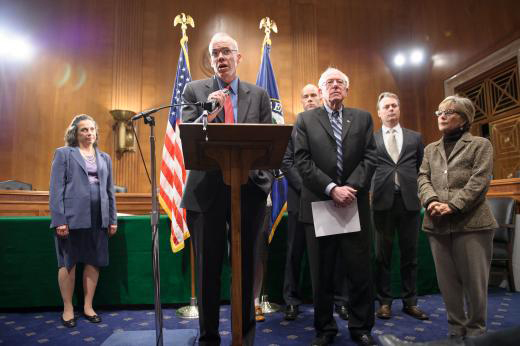
Bill McKibben, director of 350.org, speaking at the press conference (photo: Senator Bernie Sanders)
The truth of the matter is, and this is, in a sense, the good news, we know how to cut greenhouse gas emissions; the technology will only improve in years to come. Solar will become less expensive, and it has become much less expensive in recent years. It will continue to go down. Wind will become more efficient. I just talked this morning to some folks in the geothermal business, and in Vermont more homeowners are looking to geothermal - got to get the word out about that: biomass - some good developments there. We know today how to break our dependence on fossil fuels.
Now the problem is, the political problem is, that you have an energy system made up with the coal companies, the oil companies, etc. who have enormous economic and political power; you can't turn on cable television without seeing another ad from these guys. These guys buy and sell politicians, spending huge amount of money in campaign contributions. That is the problem that we have. So we’ve got a planetary crisis; in my view the United States should play a leading role. We know how to cut greenhouse gas emissions. What we need is a political effort, a grassroots effort in America putting pressure on Congress to say, “Excuse me, get your act together and protect our kids and grandchildren.”
CURWOOD: Having a committee chair behind you is extremely powerful in a situation like this. Ordinarily, the environment you just outlined, the pressure from industry would keep this bottled up in committee, but...
SANDERS: That's right and having Senator Boxer, whose been just terrific on this issue as a co-sponsor - original co-sponsor - is a huge step forward. And I think frankly it is high time that this country had a debate, a real debate on it based on facts and not disinformation. There was just a piece that the fossil fuel industry was spending over a hundred million dollars - all kinds of phony think tanks - trying to really confuse the American people and say, “Well, you know, we’re not quite sure...some people say global warming is real and it’s manmade and some people say that it’s not.” That's what they're spending zillions of dollars on; the truth is the scientific community is almost 100 percent united in saying global warming is real, that global warming is significantly caused by manmade activities, that global warming is already causing serious damage to our country and to the world and that it will only get worse. That is the reality.
CURWOOD: Tell me a bit more about the hearings...how extensive, what kind of people are you going to bring forward to make the case?
SANDERS: We're going to bring forward the leading experts on climate in the United States and in the world. I have talked to a number of them. We have already had hearings with them over the years, and what they will likely say, and have been saying recently, they've been saying, “You know, we were wrong when we talked about global warming in the past...we were wrong because we are underestimated the problem. The problem is now looking to us a lot worse, more severe, more draconian than we had thought it was.”
And I suspect that they will also tell us - and we want to be with the economics of this - is that at a time when, and your listeners know, that just last month US Congress voted $60 billion dollars - and I voted for this - to help New Jersey and New York recover from Hurricane Sandy, that terrible devastating hurricane - and my state of Vermont a year and a half ago was hit by Irene - devastation all over many parts of our state. What I think these scientists will tell us, that it makes a lot more sense in trying to address the issue of global warming, cut greenhouse gas emissions, than spending huge amounts of money every year. And I suspect that number will be more and more, rebuilding communities that were devastated by extreme weather occurrences.
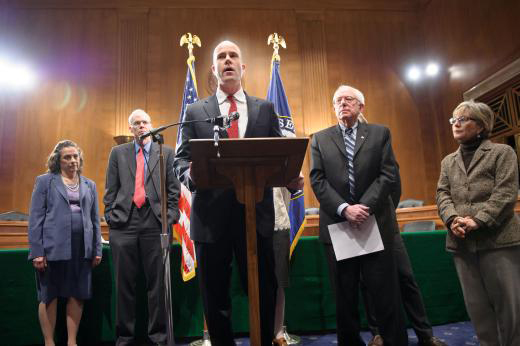
Michael Brune, director of the Sierra Club, speaking at the press conference (photo: Senator Bernie Sanders)
CURWOOD: You see opposition to your measure from Republicans...what kind of support do you see from the White House?
SANDERS: Umm - lukewarm. I think the White House will tell us that global warming is real, that we need action. My suspicion is that they will not go anywhere as near as far as they have to.
CURWOOD: I understand that Jack Lew, who’s been nominated for Treasury Secretary, has said that it’s unlikely the administration would have plans for any form of carbon taxation.
SANDERS: That's correct. That is what he's said.
CURWOOD: Now you’ve introduced a companion bill that would eliminate certain fossil fuel subsidies...what would that do?
SANDERS: Right now as everybody who is paying 4 bucks for a gallon of gas knows, our friends at ExxonMobil and the other large oil companies are doing very, very well. In fact, ExxonMobil is the most profitable corporation, as I understand it, in American history. And if you look at the federal taxes that these large corporations are paying - and it’s not just the oil companies, it’s Wall Street as well - you have some years, some years because of a variety of loopholes, and the fact that these people employ hundreds of very smart accountants, and some of these very profitable oil companies pay zero in taxes. Nothing in taxes. So we think that when you have an industry which is A: enormously profitable and B: is producing a product whose emissions are causing devastating problems for our nation and the world, we should end the subsidies that they are currently enjoying.
CURWOOD: One last question before you go, Senator. Republicans are much opposed to your proposed carbon tax. You say the White House is lukewarm about it. Here's the question: how do you get this from idea from bill to legislation to become the law the land of the United States, understanding what you’re up against?
SANDERS: Well, that's a very fair question. What Senator Boxer and I have done is brought forth what we consider to be the gold standard. And that is legislation that would actually do what the scientists are telling us has to be done. Now, do I think this is going to be an easy political fight? No I don't. You have all of the energy companies; you have the national Association of Manufacturers coming out against you; you’ve got all the big money interests coming out against it. It really boggles my mind that you have an industry who for the sake of their own profits are prepared to do terrible harm to our planet. I really do, to be frank with you - I understand people want to make money and that's okay - but that you're willing to wreck havoc on this planet for our kids and our grandchildren and our great-grandchildren in the future...that to me is unbelievable.
So do we have a hard political fight? Sure we do. But I believe, especially since Hurricane Irene, and especially Hurricane Sandy, when people are saying, “Are we going be seeing more and more of these devastating weather events which is going to cost the government and insurance
companies and homeowners so much money to rebuild, that we got to do something about it.”
So I think ultimately like everything else, you know, whether it’s the civil rights movement, or the movement toward women's rights or gay liberation or whatever it may be, the impetus will come from the people who say to Congress, “You know what, I want my kids and grandchildren and great-grandchildren to have a decent life. You’d better do something to protect the planet.” And when that happens Congress will find the courage to stand up to the big money interests.
CURWOOD: Bernie Sanders is an Independent United States Senator from Vermont. Thanks so much for taking the time with me today.
SANDERS: Well, thank you.
Related links:
- Text of the Bill
- More about Senator Sanders
- More about Senator Boxer
- US Senate Environment and Public Works Committee
- Press Release about the climate bill
[MUSIC: Conjure “Dualism (1) from Conjure: Music for the Texts of Ismael Reed (American Clave Records 1983)]
CURWOOD: There’s more on the proposed US carbon tax at our website, LOE.org. And coming up, China’s debate on the question of a carbon tax. Stay tuned to Living on Earth.
[CUTAWAY MUSIC: Van Cliburn: “Liebestraum No. 3 In A-Flat” from The World’s Favorite Piano Music (BMG entertainment 1992) R.I.P. Van Cliburn (7/12/1934 – 2/27/2013)]
Chinese Carbon Tax
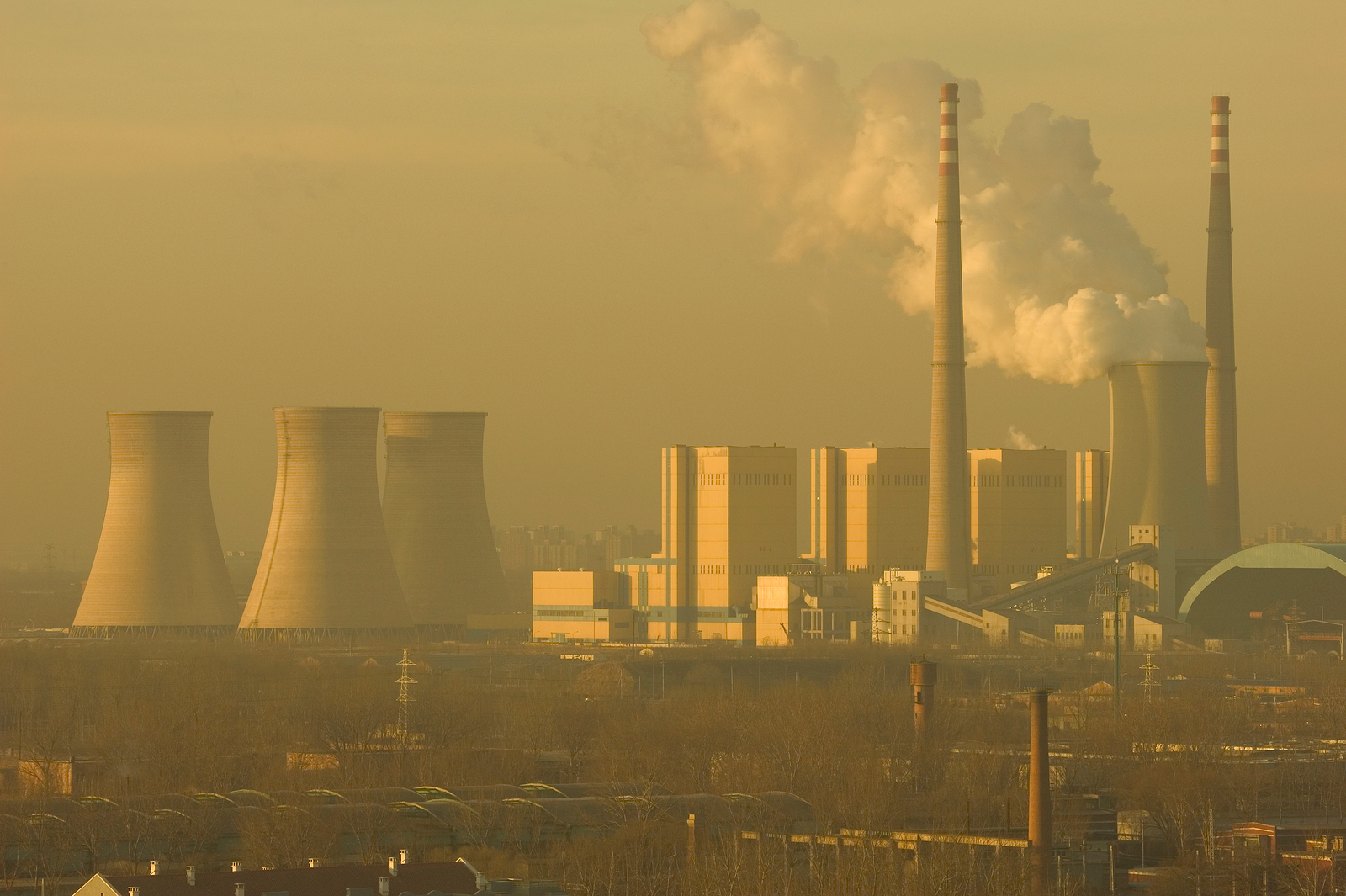
Chinese pollution (photo: bigstockphoto.com)
CURWOOD: It’s Living on Earth, I'm Steve Curwood. Not long ago China edged out the United States as the world's top carbon emitter, and debate there is intensifying over the best ways to rein in global warming emissions. An official in the Chinese Ministry of Finance recently wrote an article advocating - yes, you guessed it - a tax on carbon. Deborah Seligsohn, a former State Department official who served in Beijing, is now a researcher at the University of California at San Diego. Deborah, welcome to Living on Earth.
SELIGSOHN: Thank you.
CURWOOD: So what do you make of this news? How significant is this?
SELIGSOHN: Well, I think this is a step up in the policy discussion of a carbon tax in China. The Ministry of Finance has actually had people who for quite a long time have thought that a carbon tax was a good idea. But previous articles that we’ve seen were written by researchers or one of their affiliated think tanks. This is written by an actual officer in the Ministry. So while I’d still call it a commentary, and it’s part of a policy discussion, it is not an announcement of a new program, it indicates stronger support than we’ve seen in the past.
CURWOOD: Why do you suppose the Ministry of Finance made this move now?
SELIGSOHN: It’s hard to know. The Ministry is always looking for ways to rebalance and revive the Chinese economy. They would like to see a reduction in energy intensity, an increase in economic efficiency, a shift from heavy industrial services. These are all things they think would be good for the Chinese economy. And a carbon tax, which essentially puts an extra cost on inefficiency and high energy use, and generally sort of capital intensive industry, would be a way to advance a number of their goals.
CURWOOD: So what you’re saying is that yes, a carbon tax would affect emissions, but there’s a broader role in the economy. Is this what the advocates are talking about?
SELIGSOHN: Yes, the advocates in the Ministry of Finance are particularly actually interested in the broader impact on the economy. Then there are groups within the environmental community who are, of course, particularly concerned about this for its impact on reducing carbon dioxide emissions. The Ministry of Finance says, “We have a national commitment to reduce CO2 emissions and we have all these other goals with our economy, and this is a great way to kill two birds with one stone.”
CURWOOD: So what effect would a carbon tax have on emissions of greenhouse gas from China?
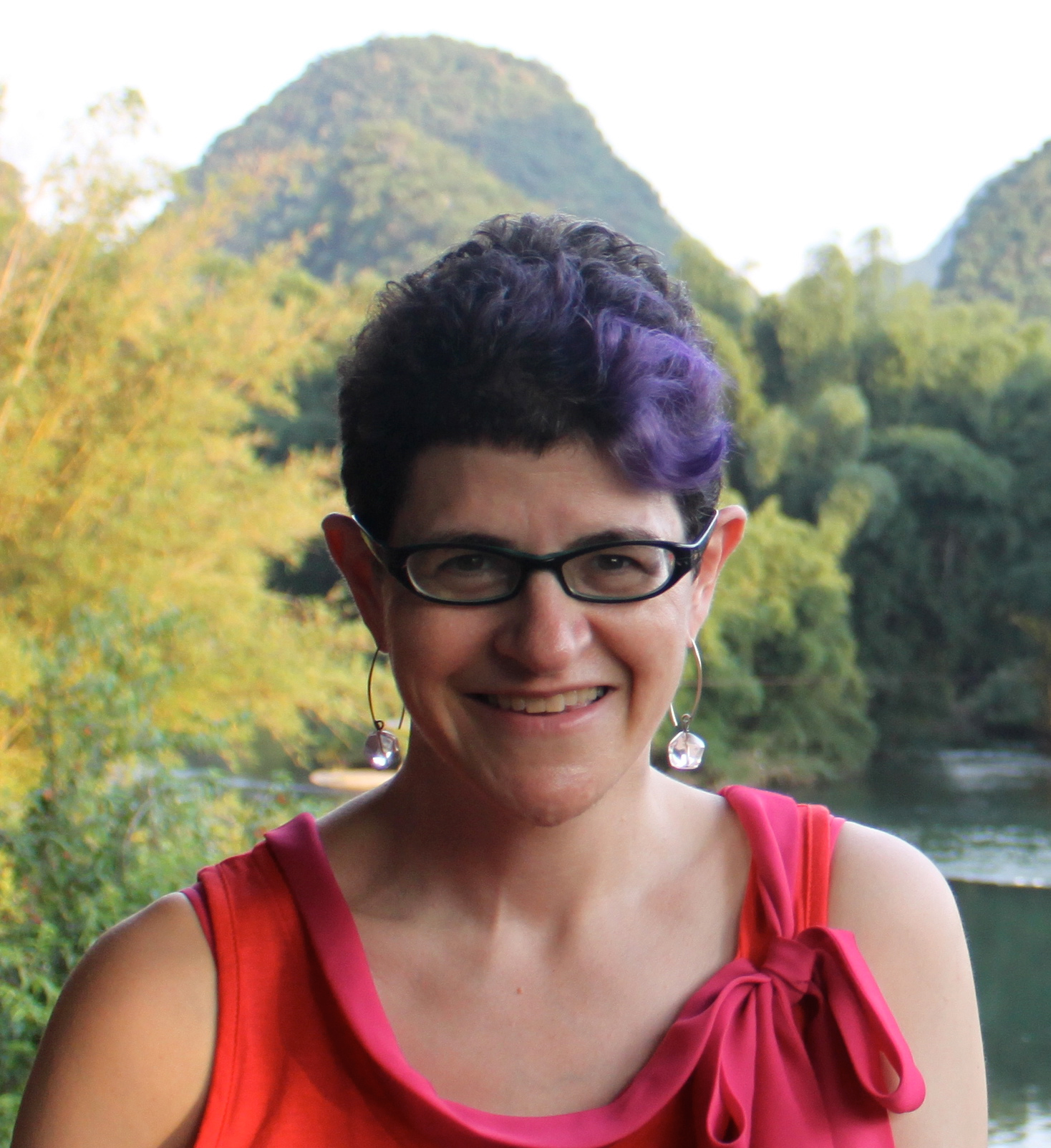
Deborah Seligsohn (photo: Kay Seligsohn Bullis)
SELIGSOHN: So a carbon tax, by adding a cost to using carbon-intensive fuels, would help reduce their use. But how much would it do so and how fast, in large part, depends on the size of the carbon tax. What is interesting is there has been a certain amount of economic modeling done on what kinds of carbon taxes would have, on what kind of impact, and there’s a lot of indication that putting a fairly modest tax on would have an impact, and if the modest tax was placed with the announced intention that it was going to increase over time, it would have quite a sizable impact because industry would start to respond not only to the current tax, but to the expected future tax hikes. So China could bring this in gradually and modestly and still have quite an impact.
CURWOOD: Now, a number of people in the United States say that this country, the US, can’t take action on climate until China starts taking it seriously. How do you respond to that?
SELIGSOHN: Well, China is taking it seriously. They have a commitment, starting in Copenhagen, to actually reduce the carbon intensity of their economy. And they take this international commitment quite seriously. China is also in the process of implementing pilot cap and trade programs in a number of cities. So different ministries within the Chinese government prefer the two different options...the National Development Reform Commission is more in favor of a cap and trade which they would run...the Ministry of Finance is more in favor of a carbon tax which it would run. So in the end which way it will come down, or whether they will actually come up with a way to combine the two, which in fact is what Australia is doing right now, I think that still remains to be seen. What is clear is that there’s a lot of policy innovation going on using market mechanisms to control carbon. Now what we know about carbon dioxide of course is certain atmospheric greenhouse gases are the ultimate public goods problem, right? Once you emit them in the world, you affect everyone in the world equally, right? So China looks at those issues and says, yes, we’re moving on CO2, but to do more we really need to see the US do more. And given that the US is by far a wealthier country, they kind of feel like, well, to match, you guys have to show that you’re moving...and frankly, the Chinese are quite skeptical that the US is going to move. What they’ve seen over and over again is they’ve done quite a few things in the last five to ten years, and over that period the US has mostly debated.
CURWOOD: Deborah Seligsohn is a Researcher at the University of California at San Diego. Thanks so much, Deborah.
SELIGSOHN: You’re welcome.
Related links:
- Deborah Seligsohn’s webpage at the World Resources Institute
- Original Story
[MUSIC: Pops Mohamad “Kalamazoo” from Essential Vibes (Melt 2000 Records)]
Amazon Deforestation on the Rise
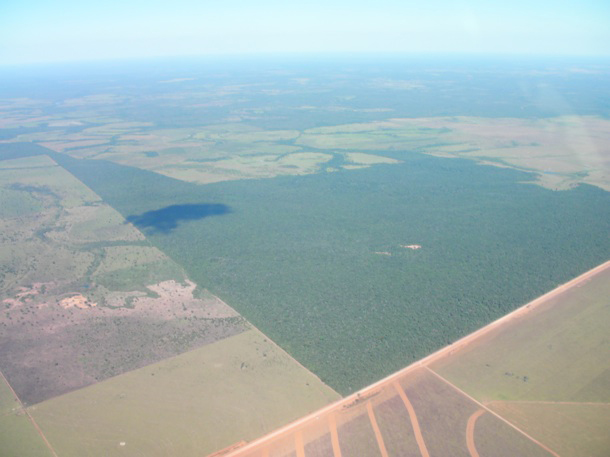
Amazon landowners must keep forest on 80% of their land. (Photo: Bobby Bascomb)
CURWOOD: Tropical forests are vital lungs for the planet, but always at risk from deforestation and development. Brazil, though, has dramatically reduced deforestation; from 2005 to 2011 rates of destruction in the Brazilian Amazon dropped some 80 percent. But in the last half of 2012 the pace of deforestation more than doubled. Paulo Barreto is a Senior Researcher at the non-profit research institute Imazon.
BARRETO: Imazon uses satellite images to evaluate monthly the deforestation. From August 2012 up to January we have seen an increase in deforestation. It’s about 120 percent higher than the same period in the previous year.
CURWOOD: Now there are several possible reasons for the rise in deforestation and one principal factor relates to changes in Brazil’s Forest Code, which protects the rainforest by limiting how much land can be cleared and developed. In May of 2012 the Brazilian Congress proposed changes to the law that had been protecting the Amazon for more than 50 years, and Living on Earth’s Bobby Bascomb brought us that story.

Cattle and soybeans are by far the largest drivers of deforestation in the Amazon (Photo: Bobby Bascomb)
BASCOMB: In the 1950s and 60s the Brazilian government encouraged people to go to the Amazon and make it productive, grow food to feed an impoverished country.
[ARCHIVE DOCUMENTARY MUSIC UP THEN UNDER]
DOCUMENTARY: It is not enough to build roads. We must colonize for agriculture or for cattle. The land is good. There are green pastures in the forest made of milk and honey.
[AMBIANCE BIRDS, ROOSTER]
BASCOMB: 92-year-old Jospe Perrer de Brito was one of those early settlers.

Jospe Perrer de Brito and his wife inside their home. Jospe paddled here in a canoe to work in agriculture in 1958. (Photo: Bruce Gellerman)
DE BRITO: When I first came here I came by paddle in 1958. There were only wild Indians living here.
[AMBIANCE, PADDLING]
BASCOMB: De Brito paddled up the Rio des Mortes, in a dug out canoe. He came to farm and raise cows.
DE BRITO: When I first came here, there was a lot of free land. Now every piece of land has been grabbed up by people. There was a lot of forest, very big. Not anymore. The people chopped it down. I think things will be worse if they chop down all of the forest.

Since the government started collecting data in the 1970s an area of rainforest nearly the size of France has been deforested to make way for agricultural production. (Photo: Bobby Bascomb)
BASCOMB: Today, half a century since De Brito paddled up the river, 150 million acres of forest has been chopped down, in spite of the Forest Code that requires land owners to keep 80 percent of their property forested. It’s called the Legal Reserve and people that cut down their Legal Reserve must reforest it and pay fines. Yet 4.6 million agricultural producers are in violation of the law.
RIEDEL: It’s a very complex situation where it made 90 percent of the producers outlaws.
BASCOMB: Eduardo Riedel represents those producers as Vice President of the National Federation of Agriculture and Livestock. He says Brazil needs the new Forest Code Congress just passed because the current law is out of step with reality. The new code would create an amnesty for people that illegally deforested before 2008. People will not have to pay the fines as long as they reforest the degraded land.
RIEDEL: We think it’s much better for the environment if you reforest than you pay the fines. It’s not an amnesty, that you don’t need anymore to pay the fine. It’s not that. You don’t pay the fine if you reforest.

Roads cut through the forest bring settlers to the Amazon and agricultural products out to ports. (Photo: Bobby Bascomb)
BASCOMB: But environmentalists and scientists see two problems with that rationale. First is the problem of enforcement. The Brazilian Amazon is roughly half the size of the continental United States, yet has just 400 environmental police to patrol the region and enforce laws. A second concern is that the amnesty clause could actually spur more deforestation. Daniel Brindis is a forests campaigner for Greenpeace, based in Brazil.
BRINDIS: The message is that you can violate the law with impunity. There might be another round of amnesty on the way or you don’t need to take the code seriously.
BASCOMB: A piece of land cleared and ready to grow soybeans or graze cows is far more valuable than the same piece of land with trees on it. So Brindis says that farmers and ranchers are choosing to deforest now, assuming another pardon will come along later.
BRINDIS: We’ve actually seen this response in a rise in deforestation rates. Over the first quarter, the first three months of the year, deforestation was triple that of the same three months from the year before.

Philip Fearnside is a research professor with the National Institute for Research in the Amazon. (Photo: Bobby Bascomb)
BASCOMB: Another change in the law directly encourages deforestation by allowing land owners to cut down trees closer to river banks. The Amazon Basin is full of meandering rivers with broad bands of dark green forest along them. The new code requires a narrower forest buffer along the rivers. That troubles Philip Fearnside, a research professor at the National Institute for Research in the Amazon.
FEARNSIDE: Those riverside forests are very important in terms of avoiding flooding and so forth and they’re also very important for biodiversity because those are the corridors that allow animals and plants to move between the different patches that are left after deforestation has advanced.

Strips of forest follow the same meandering pattern as rivers. They are called permanent protection areas.(Photo: Bobby Bascomb)
What keeps biodiversity viable is having some connection between those little patches that are left. By eliminating these areas of permanent protection you have a much greater impact on biodiversity than cutting the same area of forest somewhere else. It’s the worst place to have that extra clearing to be allowed.
BASCOMB: Most scientists agree that the new Forest Code will increase deforestation and reduce biodiversity. And Fearnside says the majority of the Brazilian public are against the changes as well.
FEARNSIDE: Brazil is now over 80 percent urban so most of the population has no direct economic stake in being allowed to deforest more. Opinion polls show most Brazilians are against this legislation but the lower house of Congress passed last May by a margin of 7 to 1 for something that’s basically against the interest of the majority of the Brazilian population.

Property owners are allowed to develop some land and must keep some as forest. From the sky the north of Brazil looks like a patchwork of forest and agricultural land. (Photo: Bobby Bascomb)
BASCOMB: Why was the Congress so overwhelmingly in support of a forest bill if the Brazilian people are not in support of it?
FEARNSIDE: That’s a good question. You have a very powerful ruralist lobby that has a tremendous amount of money. Big soy bean planters and ranchers contribute to this. It’s presented as favoring small farmers but money and influence comes from wealthy land owners. It shows very much the balance of power, which has shifted to be very anti-environmentalist.
BASCOMB: The fate of the new forest code rests on the pen of Brazilian President Dilma Rousseff. When she campaigned for the job she promised to balance economic development with environmental conservation. She has continued to say that she would veto any provision that allowed amnesty for illegal deforestation. The Brazilian public is holding her to that promise with a widespread campaign known as “Veta Dilma” – “Veto the forest code President Dilma”.

President Dilma Rousseff has the power to veto the new forest code but congress could overturn her veto. (Wikimedia Commons)
The slogan even made its way to an awards ceremony for the former president Lula, hosted by a famous Brazilian actress Camila Pitanga.
[PORTUGUESE THEN ENGLISH]
PITANGA: Mr. President I will break protocol for a moment, only to ask you one thing...Veta Dilma.
[CROUD ERUPTS WITH CLAPPING AND CHEERING]
CURWOOD: That’s Bobby Bascomb’s report from May of last year. And Bobby joins me in the studio now to talk about what’s happened since then. Hi, Bobby.
BASCOMB: Hi Steve.
CURWOOD: So, what did president Dilma Rousseff decide in the end?
BASCOMB: Well, she used her line item veto to strike down 12 provisions proposed by Congress. That achieved more protection for the forest than the Congress wanted but far less than what the original law provided. And now, as predicted, deforestation is suddenly rising after years of decline. Paulo Barreto from Imazon says weakening the forest code is one of the principle reasons.
BARRETO: The National Congress, they changed the Forest Code last year to give an amnesty to some illegal deforestation. So, this gives a sign that Congress then can validate illegal operation, illegal logging, illegal deforestation. So, that’s a bad sign that people get in the field and they get more confident to deforest.
BASCOMB: On top of that there’s also been a rise in the market price of agricultural commodities like soy and cattle, which are the biggest drivers of deforestation in the Amazon. And then there’s another factor, hydroelectric dams…
CURWOOD: Dams?
BASCOMB: Yeah, there are about 60 hydroelectric dams in the works and the government has removed protection from the parts of the forest where they're planned. It’s not that much forest but the bigger issue is that farmers see the government developing in protected areas and think, why can’t I?
CURWOOD: So, all these factors together are causing deforestation rates in the Brazilian Amazon to double?
BASCOMB: Exactly, but it’s important to note that the deforestation data has not been confirmed by the government - officials stopped releasing monthly data a couple of months after the rate of deforestation started to increase. Observers I talked to think the decision to suddenly stop reporting that information is political. One of them is Gustavo Faleiros, he’s a Knight International Journalism Fellow.
FALEIROS: We start realizing that the Brazilian government is delaying a lot the release of new data on deforestation. And we realized that deforestation was increasing. So, it was impossible not to ask yourself why the government was delaying so much this data.
BASCOMB: Gustavo's set up a website, called InfoAmazonia to get the information out.
CURWOOD: And how does that work?
BASCOMB: Well, the website collects data from satellites and other sources and compiles it in one place where you can build your own maps of the Amazon, all nine countries. And there are layers of real time data on mining, oil concessions, cattle ranching, hydroelectric dams… all the biggest drivers of deforestation. And the results can be really powerful. When you overlay cattle ranching with deforestation, for instance, it becomes pretty obvious that there’s a close relationship there.
CURWOOD: So, the whole is greater than the sum of the parts here.
BASCOMB: Yes, but there’s one more really cool thing. There’s another map layer and that’s journalists’ stories from the Amazon.
So let’s say you’re looking at a map of gold mining in Peru, you can then click on icons that will take you to stories about Peruvian gold mining, and later this year InfoAmazonia plans to incorporate data collected by citizens. So, small NGO’s, scientists, or indigenous groups can collect data on water quality or wildlife for example and upload it to the website. Gustavo thinks this kind of information is important to the world, not just Amazonian countries.
FALEIROS: Well, the Amazon is for sure like the mirror of humanity in a way. A lot of people are looking, what are we going to do with the last pristine area in the world. Everyone wants to see if we’re going to be able to hold that thing for the future.
BASCOMB: That's Gustavo Faleiros. There's a link to his website, InfoAmazonia at our website, LOE.org.
CURWOOD: That’s Living on Earth’s Bobby Bascomb. Thanks, Bobby.
BASCOMB: You’re welcome.
Related links:
- LOE Documentary, Carrots and Sticks: Saving the Amazon and Stalling Climate Change
- InfoAmazonia
- Imazon
[MUSIC: Azymuth “Light As A Feather” from Light As A Feather (Black Sun Music 1972)]
CURWOOD: Coming up...we check out an unusual incentive to buy a new car - free solar panels. Keep listening to Living on Earth.
ANNOUNCER: Funding for Living on Earth comes from the Grantham Foundation for the protection of the environment, supporting strategic communications and collaboration in solving the world’s most pressing environmental problems. The Gordon and Betty Moore Foundation. The Kendeda Fund, furthering the values that contribute to a healthy planet. And Gilman Ordway for coverage of conservation and environmental change.
This is PRI, Public Radio International.
[CUTAWAY MUSIC: Dexter Gordon: “Three O’Clock In The Morning” from Go (blue Note Records 1999 Reissue) Happy Birthday Long Tall Dexter (2/27/1923 – 4/25/1990)]
Science Note: A Plant With Oily Leaves

MSU has successfully engineered a plant with oily leaves -- a feat that could enhance biofuel production as well as lead to improved animal feeds. (Photo: Kurt Stepnitz)
CURWOOD: It's Living On Earth, I'm Steve Curwood. Just ahead - the smallest and most prolific life-forms on the planet, but first this note on emerging science from Naomi Arenberg.
ARENBERG: MmmMmmGood! That might be what some lucky caterpillars living in a Michigan State University laboratory are saying. These larvae were fed leaves engineered to contain significantly more oil than average leaves. The experiment was conducted by a research team at MSU. Their leafy goal is two-fold – first, to increase plant production of biofuels and, second, to create more nutritious feed for non-human animals.
Until now most biofuel research has worked on seeds, where oil naturally occurs, as food for the nascent plant. But the MSU team is experimenting with oil production and storage in leaves, hoping to double energy capacity by using more of the plant. The team inserted a gene from green algae into the leaf of thale cress, or Arabidopsis thaliana. That’s a small, flowering plant, widely used in genetic research because of its relatively short life cycle.
The next phase is where the caterpillars come in. To prove that the modified cress leaves were a good source of oil, the team fed them to the fuzzy, little crawlers, who gobbled them up and grew a bit more roly-poly than caterpillars in a control group.
The next experimental step will be to find a way to commercialize this development by boosting oil production in algae and grasses that can grow on land unsuitable for agriculture. So, when you next drive past a grassy field, you could be looking at a future source of fuel for your next fill-up. That’s this week’s note on emerging science. I’m Naomi Arenberg.
Related links:
- Michigan State University on Fat Worms
- Article in The Plant Cell, the journal of the American Society of Plant Biologists
Honda and Solar Energy
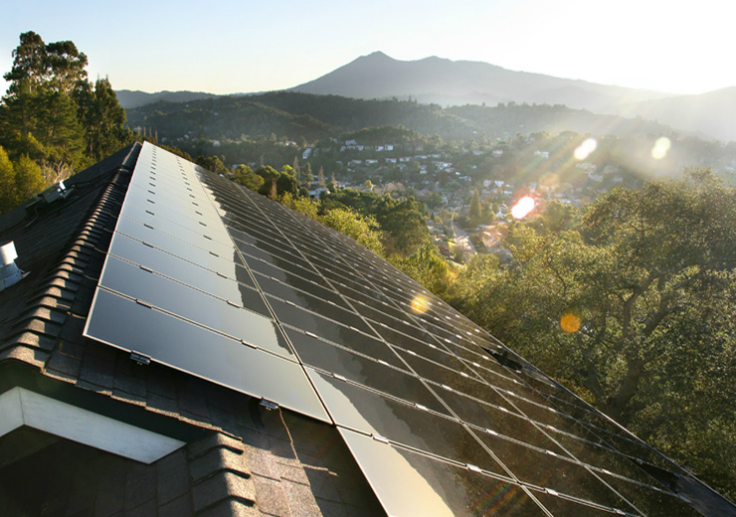
(Photo: Solar City)
CURWOOD: Zero percent financing. $1000 dollars cash back. Car sales people always seem to have some great incentive to get people into the showroom, and to sign on the bottom line. But Honda has come up with one that seems likely to benefit not only the potential car-buyer, but also the planet.
The car company has partnered with Solar City to offer customers in the 14 states where the installer operates photovoltaic panels for their homes at little or no cost. We called up Ryan Harty, assistant Manager of Honda's Environmental Business Development Office to find out what the company was thinking, and why it chose this kind of incentive.
HARTY: Honda has set an internal goal to achieve minus 50 percent CO2 reductions by 2050. By addressing the customers home electricity carbon dioxide reduction we can take a big big step towards that, as well as prepare the future market for electric vehicles, plug-in hybrid and home fueled hydrogen fuel cell vehicles in order for those vehicles to be refueled by renewable electricity at the customer’s home.
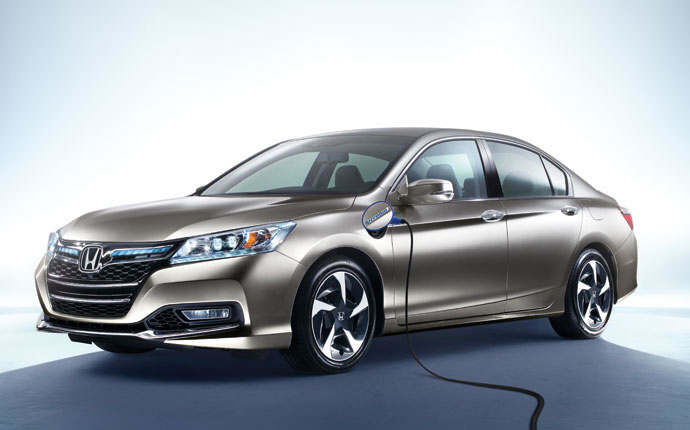
Honda Accord Plug-In Hybrid (Photo: American Honda Motors)
CURWOOD: So this isn’t a completely new idea – Ford partnered with Sunpower in 2011 to provide solar panels people who bought electric Ford Focus. How much of the Ford experience affects your approach?
HARTY: I believe that our program is exponentially larger than that. Our program reaches not just to our electric vehicle customers and the Accord plug-in hybrid customers, but very broadly to all of our automobile, Honda and Acura customers.
CURWOOD: So if I have a Honda motorcycle, I’m eligible?
HARTY: Absolutely. If you have a relationship with Honda through any product you purchased or just by searching for information our website, or if you called in, you'll be eligible to join our offer.
CURWOOD: What's in it for the customer here?
HARTY: Very simply, the customer gets to enjoy clean carbon-free electricity that they generate by themselves at a cost that’s less than what they were currently paying for utility power.
CURWOOD: That means that the electricity cost is fixed under this arrangement.
HARTY: The customer’s given a range of options. The zero down payment option will have an inflation escalator every year for the cost of the electricity they purchase. If the customer chooses to put some down payment, they will fix their electricity costs for the duration of the contract and obviously if they decide to pay cash themselves for the system then their electricity is free for the life of the system.
CURWOOD: Now tell me what comes with the solar panel installation. I imagine it might include an electric vehicle charging station?
HARTY: It could be if you are in the market for an electric vehicle. Our partner Solar City will investigate your house. They'll tell you about the different rates that your utility has for electricity for your electric vehicle. And also through our partner Leviton we would arrange the installation of an electric vehicle charging station at your home.
CURWOOD: So, what’s in this for Honda? How does it help Honda’s bottom line?

Honda and SolarCity are partners in providing $65 million in financing for solar panel installations. (Bigstockphoto.com)
HARTY: What's in it for Honda, right off the top, is a very modest financial return that Honda gets from this investment. But much more importantly is the connection that we make with our customer. We believe we're providing them with a product that will give them a joy of ownership for the next 20 years and beyond. The idea that they can wake up every single day and refuel their car and heat and cool their home with renewable electricity, and that they have Honda to thank for making that introduction is very valuable to Honda.
CURWOOD: So how does Honda make money on this deal?
HARTY: We make a very modest return on this deal by providing the capital to Solar City to install the systems. We make a certain return in the form of tax credits and depreciation from the system. Honda is an owner of all of the systems that will be installed in this program, and we take our return in the form of tax credits and depreciation.
CURWOOD: So it's like this leasing a car.
HARTY: Essentially, yes.
CURWOOD: So if there's ever a carbon tax, Honda will be, well, will have a whole bunch of credits.
HARTY: [LAUGHS.] That was not the consideration by going into this. This was not us thinking broadly about future carbon markets and trying to hedge against some impacts. We don't get any credits, we don't get any café credits for doing this. This is very much a pure greenhouse gas reduction activity by American Honda.
CURWOOD: How much is Honda putting into this project at this point?
HARTY: We haven’t disclosed the exact amount. Between Honda and Solar City, the total investment is $65 million dollars, as well as the incentive that the customers receive by doing this is an additional $400 per customer on top of the offer that Solar City happens to be running.
CURWOOD: Where exactly can people take advantage of this Honda program for these solar panels at no upfront cost?
HARTY: Any of the 14 states that Solar City has operations in the customers can partake in the program.
CURWOOD: So 14 states have it - that means that 36 don't. How soon will Honda expand to the entire country with this?
HARTY: Well, unfortunately, some states at this time do not allow third-party financing which is what this program is doing. Some states do not have net energy metering laws, which is necessary for the customer to get a financial benefit by installing solar panels. Some utility companies in certain states don't even allow customers to install solar panels. So this is very much a state-by-state, utility-by-utility market right now.
CURWOOD: How many people do you think are going to jump at this offer?
HARTY: We estimate 2500 to 3000 residential customers, plus ten to 20 of our dealerships.
CURWOOD: And I imagine you’re saying that it's going to sell out.
HARTY: We sure hope it's going to sell out. My dream is that it sells out quickly and I have to go back to our board and ask for more money.
CURWOOD: Ryan Harty is the Assistant Manager of the Environmental Business Development Office of American Honda.Thank you so much Ryan.
HARTY: Thank you very much.
Related links:
- Honda statement
- Solar City statement
[MUSIC: Lee Ritenour “Sun Song” from Captain Fingers (Sony Music 1977)]
The Vital Role of Bacteria
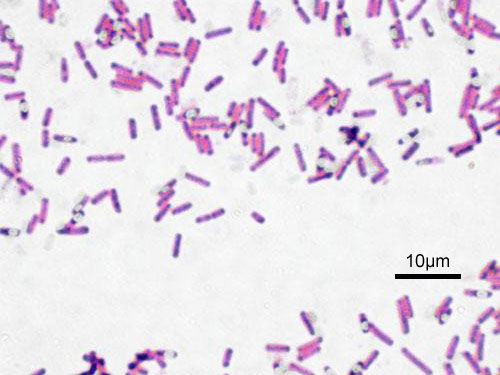
Bacillus subtillis (Wikimedia Commons)
CURWOOD: Now think of bacteria, and people often want to reach for the anti-microbial spray and clean the place up. But the increasing understanding of the vital role played by the microbiome in ourselves and in the world around us is winning these tiny critters some new respect. And that'd likely be just fine for the subject of our next story. From the Encyclopedia of Life special series, One Species at a Time, here's Ari Daniel Shapiro.
SHAPIRO: Over the last few years, we've created more than 60 episodes for this series, But there’s one group we’ve neglected – the bacteria.
KOLTER: The most spectacular aspect of life on the planet Earth is the stuff we don’t see.
SHAPIRO: Roberto Kolter is a bacteria fanatic. He’s a microbiologist, after all.
[BLINDS ROLLING UP]
SHAPIRO: Kolter lifts the blinds of one of his office windows at the Harvard Medical School. He looks outside, and he says everything he sees - depends on bacteria. For instance he people bundled up on the street below rely on the bacteria in their guts to digest their food. There’s the dirt...
KOLTER: A lot of that soil is actually produced by bacterial activity.
SHAPIRO: Even the trees dotting the landscape.
KOLTER: Without the microbes, none of those trees would make it.
SHAPIRO: And it’s this last point - that most plants really benefit from a remarkable relationship with bacteria – that Kolter’s especially interested in. To explain, let’s focus on a particular bacteria – a tiny rod-shaped cell called Bacillus subtilis. This little guy is everywhere on the planet.
KOLTER: Glaciers in Alaska, deserts in Africa, swamps in South America. You take a sample, and then you ask, “Is Bacillus subtilis there?” And it’s there.
SHAPIRO: This single cell has a rotating flagellum that it uses to propel itself through the soil. And Bacillus subtilis keeps on moving until it bumps into a plant root. Then, molecules from the plant stop the bacterium in its tracks.
KOLTER: It recognizes that it’s at the root, and that it detects as a signal to dramatically change its lifestyle. So it actually sheds being a nomadic cell that is searching. And now it ceases to separate as it divides.
SHAPIRO: In other words, Bacillus subtilis becomes multi-cellular, something you might not expect from a single-celled bacterium.
KOLTER: It makes long chains of cells. They are long threads, but then the threads - they are bundled side by side.
SHAPIRO: The result: Bacillus subtilis helps create a coating around the root, something called a biofilm. And a special kind of give-and-take emerges.
KOLTER: Any chemicals that the bacteria secrete are gonna be readily accessible to the plant. So they secrete some compounds that we know help in the growth of the plant. They also secrete compounds that are anti-fungal agents - actually, they go out and kill potentially dangerous fungi.
SHAPIRO: So they’re kind of like a catering service for the roots?
KOLTER: A bit more like a pharmacy providing lots of wonderful chemicals that help the plant. Importantly, the plant releases through its roots a lot of small molecules, many of which are wonderful food for the Bacillus subtilis, so it’s a beautiful case of a mutualistic symbiosis.
SHAPIRO: Kolter thinks that most plants depend on bacteria in exactly this way - and not just Bacillus subtilis, but an array of microbial species. Each plant root is enrobed in a complex microscopic community. Now, I’d always thought of bacteria as single-celled beings. But the more Kolter told me about biofilms, the less the bacteria sounded like bacteria. And the more they sounded like...us.
KOLTER: Within the biofilm, some cells are making matrix, other cells are making signals, just like you have heart tissue, and you have lung tissue.
SHAPIRO: Not all bacterial cells within the biofilm are the same. They differentiate, and take on different roles. Of course, all those instructions - on how to function as a biofilm - are contained within the genes of Bacillus subtilis. For most creatures - animals, plants, fungi - it’s our genes that define which species we belong to. Elephant genes stay in elephants. Maple tree genes stay in maple trees. But in bacteria, things are - you guessed it - more complicated. In fact, it kind of throws our whole One Species at a Time approach out the window. Because of something called horizontal gene transfer.
KOLTER: That is, genes freely move from one species to another species. And it is such a large percentage of bacteria that is making up this pool of genes that is moving back and forth, that to say that it is this set of genes that makes a particular species is impossible. Because many of those genes will be found in bacteria that are dramatically different.
SHAPIRO: Before I leave, Kolter takes me over to the wall behind his desk
[SOUND OF RUNNING FINGERS ON IRON]
And he runs his fingers along a rusted iron sculpture that’s almost as tall as I am. It’s a branching tree of life, and he worked with a Colombian ironworker to fashion it. Kolter points to three little stems.
KOLTER: That’s the animals, the plants and the fungi. That’s it - this tiny little corner of the tree.
SHAPIRO: Meaning that genetically, animals, plants, and fungi aren’t all that different from one another. But the rest of the sculpture - the long branches, the sudden bends - that’s where - in Kolter’s view - the real beauty of life is. Amongst the countless diverse microbes that feed on everything from sunlight to sulfur. That live from the top of the atmosphere to the bottom of the ocean. And that defy any kind of box you try to put them in. For Living on Earth, I'm Ari Daniel Shapiro.
CURWOOD: Our story on bacteria is from the series, One Species at a Time, produced by Atlantic Public Media with support from the Encyclopedia of Life.
Related link:
Encyclopedia of Life, Bacteria
[MUSIC: Neil young “Walk Like A Giant” from Psychedelic Pill (Reprise Records 2012)]
CURWOOD: Living on Earth is produced by the World Media Foundation. Bobby Bascomb, Emmett Fitzgerald, Helen Palmer, Adelaide Chen, James Curwood, and Gabriela Romanow all help to make our show, and we welcome Naomi Arenberg and Qainat Khan to our crew. Jeff Turton is our technical director. Alison Lirish Dean composed our themes. You can find us anytime at LOE.org - and check out our Facebook page - it’s PRI’s Living on Earth. And we tweet from @livingonearth. I'm Steve Curwood. Thanks for listening.
ANNOUNCER: Funding for Living on Earth comes from Stonyfield Farm, makers of organic yogurt, smoothies, and more. Stonyfield invites you to just eat organic for a day. Details at just eat organic dot com. Support also comes from you our listeners. The Go Forward Fund and Pax World Mutual and Exchange Traded Funds, integrating environmental, social and governance factors into investment analysis and decision making. On the web at Pax World dot com. Pax World, for tomorrow.
ANNOUNCER 2: PRI Public Radio International.
Living on Earth wants to hear from you!
Living on Earth
62 Calef Highway, Suite 212
Lee, NH 03861
Telephone: 617-287-4121
E-mail: comments@loe.org
Newsletter [Click here]
Donate to Living on Earth!
Living on Earth is an independent media program and relies entirely on contributions from listeners and institutions supporting public service. Please donate now to preserve an independent environmental voice.
NewsletterLiving on Earth offers a weekly delivery of the show's rundown to your mailbox. Sign up for our newsletter today!
 Sailors For The Sea: Be the change you want to sea.
Sailors For The Sea: Be the change you want to sea.
 The Grantham Foundation for the Protection of the Environment: Committed to protecting and improving the health of the global environment.
The Grantham Foundation for the Protection of the Environment: Committed to protecting and improving the health of the global environment.
 Contribute to Living on Earth and receive, as our gift to you, an archival print of one of Mark Seth Lender's extraordinary wildlife photographs. Follow the link to see Mark's current collection of photographs.
Contribute to Living on Earth and receive, as our gift to you, an archival print of one of Mark Seth Lender's extraordinary wildlife photographs. Follow the link to see Mark's current collection of photographs.
 Buy a signed copy of Mark Seth Lender's book Smeagull the Seagull & support Living on Earth
Buy a signed copy of Mark Seth Lender's book Smeagull the Seagull & support Living on Earth

